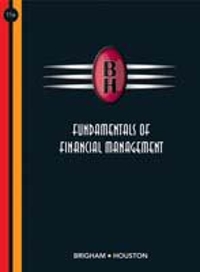True/False. (2 points each) Write ?T? if the statement is true and ?F? if the statement is false 1. There are 4 corporate levels of Risk Management. ____ 2. Subjective risk does not refer to the mental state of someone who experiences doubt as to the outcome of a given event. ____ 3. Objective Risk= Probable variation of actual from expected losses Expected Losses ____ 4. Pure risk exists when there is no uncertainty as to whether a loss will occur. ____ 5. The principle of subrogation grows out of the principle of indemnity. ____ 6. Profits determine the investor?s rate of return. ____ 7. Market risk is non-diversifiable risk. ____ 8. If I go to a car dealer to see a Mustang, and I end up buying a Taurus this is called the collaborative effect. ____ 9. Brainstorming is a quantitative measurement tool. ____ 10. All measures with a frequency-reduction focus are called pre-loss activities. Multiple Choice (3 points each). Choose the one alternative that best completes the statement or answers the question. 11. Which of the following is an example of loss control a) Separation b) Credit c) Reserve Funds d) All of the above 12. Which of the following types of risk is diversifiable? a) Company Risk b) Betagenic Risk c) Market Risk d) All of the above 13. Which of the following does not describe shareholder diversification? a) Insurance Companies b) Stock Market c) SBUs d) All of the above 14. Which of the following is part of the Wrapped Model? a) Strategic Wrapper b) Synergy Wrapper c) Planning Wrapper d) Insurance Wrapper 15. Problems of MNCs include: a) Global Control b) Cash management & positioning of funds c) Managing Receivables d) All of the above 16. Which of the following is not a step in the risk management decision-making process? a) Identify all significant risk that can cause loss b) Evaluate the potential frequency and severity of loss c) Understanding shareholder wealth d) Implement the risk management methods chosen
FIN 415 Final Exam When finished, submit your answers via your Gradebook. DO NOT discuss this with any other person - this is your individual final exam!! For the multiple choice & true/false answers only submit the question number and answerdo not include the question in your answer sheet. For other questions/problems, please show all of your work for full credit. One Excel attachment is preferred, otherwise be sure to show your work if you choose Word do not send more than one attached file. Good luck! True/False. (2 points each) Write \"T\" if the statement is true and \"F\" if the statement is false 1. There are 4 corporate levels of Risk Management. ____ 2. Subjective risk does not refer to the mental state of someone who experiences doubt as to the outcome of a given event. ____ 3. Objective Risk= Probable variation of actual from expected losses Expected Losses ____ 4. Pure risk exists when there is no uncertainty as to whether a loss will occur. ____ 5. The principle of subrogation grows out of the principle of indemnity. ____ 6. Profits determine the investor's rate of return. ____ 7. Market risk is non-diversifiable risk. ____ 8. If I go to a car dealer to see a Mustang, and I end up buying a Taurus this is called the collaborative effect. ____ 9. Brainstorming is a quantitative measurement tool. ____ 10. All measures with a frequency-reduction focus are called pre-loss activities. Multiple Choice (3 points each). Choose the one alternative that best completes the statement or answers the question. 11. Which of the following is an example of loss control a) Separation b) Credit c) Reserve Funds d) All of the above 12. Which of the following types of risk is diversifiable? a) Company Risk c) Market Risk b) Betagenic Risk d) All of the above 13. Which of the following does not describe shareholder diversification? a) Insurance Companies b) Stock Market c) SBUs d) All of the above 14. Which of the following is part of the Wrapped Model? a) Strategic Wrapper b) Synergy Wrapper c) Planning Wrapper d) Insurance Wrapper 15. Problems of MNCs include: a) Global Control b) Cash management & positioning of funds c) Managing Receivables d) All of the above 16. Which of the following is not a step in the risk management decision-making process? a) Identify all significant risk that can cause loss b) Evaluate the potential frequency and severity of loss c) Understanding shareholder wealth d) Implement the risk management methods chosen Using the table below, calculate the following for 17 through 19 (10 points each): COUNTRY CONTRACT $/FOREIGN CURRENCY Canadadollar Spot .8437 30day 90day .8417 .8395 Japanyen Spot 30day 90day .004684 .004717 .004781 Switzerlandfranc Spot 30day .5139 .5169 90day .5315 17. An American business needs to pay (a) 15,000 Canadian dollars, (b) 1.5 million yen,and (c) 55,000 Swiss francs to businesses abroad. What are the dollar payments to the respective countries? 18. An American business pays $20,000, $5,000, and $15,000 to suppliers in, respectively, Japan, Switzerland, and Canada. How much, in local currencies, do the suppliers receive? 19. Compute the indirect quote for the spot and forward Canadian dollar, Japanese Yen, and Swiss franc contracts. 20. You are considering a security with the following possible rates of return: Probability Return (%) 0.30 0.15 0.25 0.30 9.5 12.0 15.0 16.0 Calculate the expected rate of return and the standard deviation of the returns. 21. Probability Return (%) 0.15 0.30 0.40 0.15 6 5 11 14 Calculate the expected rate of return and its standard deviation. One year Treasury bills are currently paying 8.9%. Should you invest in the above security? 22. GAC Manufacturing, Inc. is considering several investments. The rate on T-Bills is currently 6.75 percent, and the expected return for the market is 12 percent. What should be the required rates of return for each investment (Using the CAPM)? 12 points. Security Beta A B C D 1.40 0.75 0.80 1.20







